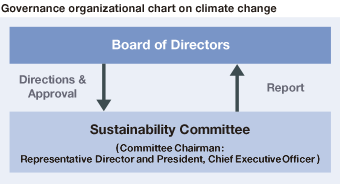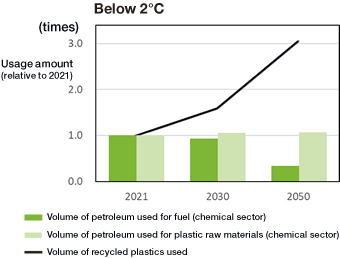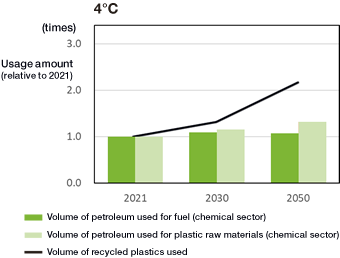Disclosure Based on the TCFD Recommendations
Governance
At least once a year, the Unitika Board of Directors receives a report from the Sustainability Committee on sustainability-related matters including actions for climate change. The Board of Directors also monitors the progress status of the KPIs of Unitika Group’s priority issues, and incorporates the findings into the medium-term management plan.
The Committee Chairman of the Sustainability Committee is the Representative Director and President, Chief Executive Officer of Unitika. The Board of Directors gives directions and grants approval on initiatives to address the climate-related issues reported on by the Sustainability Committee. We are making efforts to enhance disclosure, such as setting up a TCFD working group to promote disclosure based on the TCFD recommendations, under the direction of the Sustainability Committee.


Strategies
The Unitika Group recognizes the following items as important risks and opportunities related to climate change. We will conduct even more in-depth scenario analyses, while selecting the target businesses and application areas in Unitika Group. Furthermore, we will review the risks and opportunities as required, as we gradually expand the range of information for disclosure.
(1) Identifying Risks and Opportunities
We have identified the main short-, medium- and long-term risks and opportunities in the Unitika Group that are related to climate change, and organized them in the following items. This fiscal year we have identified the relevant risks and opportunities common to all businesses, as well as identifying the unique risks and opportunities of the lifestyle and safety areas that are the main applications of products in the Polymers segment, which is one of the three segments of the Unitika Group.
| Category | Cause | Businesses impact |
Financial impact |
Main action | Time axis*1 |
All*2 | Lifestyle*3 | Mobility*4 | |
|---|---|---|---|---|---|---|---|---|---|
| Transition risks |
Regulation | Strengthening of GHG emissions regulations | Rise in the prices of energy and raw materials due to the introduction of carbon pricing | Increase in operating costs Increase in procurement costs |
|
Medium term | ● | ||
| Strengthening of regulations on processing waste products | Decline in laminated products | Decrease in sales |
|
Medium term | ● | ||||
| Market | Development of a circular economy and decarbonized society | Decrease in the demand for Unitika products due to the switch to a low-carbon consumption style (returnable containers, etc.) and a fall in the demand for materials with a substantial environmental impact | Decrease in sales |
|
Medium term | ● | |||
| Technologies | Development of a circular economy and decarbonized society | Increase in the burden to develop environmentally-responsive (circular economy) technologies | Increase in research and development costs |
|
Medium term | ● | |||
| Reputation | Changes in evaluation in the market | Decline in corporate value due to a worsening brand image, and exclusion from investment targets | Increase in capital costs |
|
Long term | ● | |||
| Physical risks |
Acute | Increase in climate-related disasters (floods and droughts, etc.) | Disaster-related damage to the Unitika Group’s plants | Increase in recovery and restoration costs Decrease in sales |
|
Short term | ● | ||
| Increase in climate-related disasters Decrease in sales |
Suspension in the delivery of raw materials and parts, etc. due to disaster-related damage to the plants of business partners | Decrease in sales | Short term | ● | |||||
| Chronic | Increase in climate-related disasters | Rise in insurance costs due to a global increase in insurable events and related claims | Increase in insurance costs | Long term | ● | ||||
| Opportunities | Products and services |
Development of a circular economy and decarbonized society | Increase in demand for biomass-derived materials and recycled materials | Increase in sales |
|
Medium term | ● | ||
| Development of a circular economy and decarbonized society | Increase in demand for products that contribute to a reduction in food loss and waste (gas barrier films, etc.) | Increase in sales | Medium term | ● | |||||
| Development of a circular economy and decarbonized society | Increase in vehicle weight reduction and related products for batteries due to the shift to EVs | Increase in sales | Medium term | ● | |||||
| Strengthening of subsidized businesses associated with the development and implementation of environmentally-responsive materials | Decrease in capital costs |
|
Short term | ● | |||||
*1 Time axis (period until the risks and opportunities manifest) Short term: Around 2025, Medium term: Around 2030, Long term: Around 2050
*2 All (common risks and opportunities in all segments)
*3 Lifestyle (risks and opportunities unique to the lifestyle and safety areas that are the main applications of products in the Film segment and Plastic segment.)
*4 Mobility (risks and opportunities unique to the automotive and mobility areas that are the main applications of products in the Film segment, Plastic segment and Nonwoven segment.)
(2) Implementation of Scenario Analysis
We analyze the set scenarios of (a rise in the global average temperature of) below 2°C and 4°C on themes in the list of climate-related risks and opportunities that are evaluated as being of high importance for the Unitika Group, taking into consideration the impact on businesses, relevance to business strategies, and interest level of stakeholders, etc. Listed below are the results of a scenario analysis review. We also recognize the physical risks of a 4°C scenario as mainly being floods and droughts, etc. We will continue to verify and evaluate these risks.
| Below 2°C | 4°C | |
|---|---|---|
| Set scenarios (of a rise in the global average temperature) |
|
|
IEA : International Energy Agency
WEO : World Energy Outlook
APS : Announced Pledges Scenario
STEPS : Stated Policies Scenario
SSP : Shared Socio-economic Pathways
RCP : Representative Concentration Pathways
Scenario Analysis I (Opportunities)
Increase in Demand for Recycled Plastics
<Impact Assessment>
As for the volume of petroleum used in the chemical sector in a below 2°C scenario, although the amount used for fuel is expected to decrease, the amount used for plastic raw materials is assumed to increase as per in the 4°C scenario. In either scenario, the demand for plastics derived from petroleum resources is forecast to continue going forward. Also within this, the volume of recycled plastics used is expected to increase in either scenario of below 2°C and 4°C, with a particularly large increase anticipated in the below 2°C scenario. As the move toward a circular economy and decarbonized society progresses, the demand for recycled plastics is forecast to increase going forward.




In addition to the traditional businesses of fibers and resins, we are strengthening the food packaging films “Emblem CE” and “Emblet CE,” which are made using recycled materials obtained from chemical recycling and materials recycling methods.
Scenario Analysis Ⅱ (Opportunities)
Increase in Demand for Products that Contribute to a Reduction in Food Loss and Waste
<Impact Assessment>
The overall global demand for food is expected to rise going forward, and the issue of food loss and waste is anticipated to become increasingly important. As for trends in the reduction of food loss and waste, the Food and Agriculture Organization of the United Nations (FAO) monitors the ratio of food loss and waste worldwide. The Sustainable Development Goal SDGs 12 of “Responsible Production and Consumption” has set the target 12.3 of “By 2030, halve per capita global food waste at the retail and consumer levels and reduce food losses along production and supply chains, including post-harvest losses.” As society strives to achieve the SDGs, the demand for products that contribute to a reduction in food loss and waste is expected to keep rising going forward.
<Action Strategies>As we accelerate the development of high value-added products such as the barrier nylon film "Emblem HG", we are also strengthening the expansion of sales in overseas markets where the issue of food loss and waste is anticipated to become increasingly important.
Scenario Analysis III (Opportunities) Increase in products related to vehicle weight reduction and batteries in the shift to EVs
<Impact Assessment>The number of new EVs sold is expected to increase under both the 4°C scenario and the below 2°C scenario, but under the below 2°C scenario in particular, the ratio of EV sales in 2050 is estimated to increase significantly.
The Unitika Group’s main EV-related products include nylon 6 resin (for automobile applications) and nonwoven fabrics (for automobile applications), which contribute to EV vehicle weight reduction, and LIB film (for EV battery applications), which is used in EV batteries. The market for each of the applications is expected to grow in proportion to the EV market, but it will be necessary to switch products that contribute to vehicle weight reduction from those currently sold for gasoline-powered vehicles to those suitable for EVs. The market for LIBs for EVs is expected to expand in the future due to the shift to EVs, and demand for pouch-type LIBs using film is expected to increase accordingly.
<Action Strategies>Regarding nylon 6 resin (for automobile applications), we will strengthen marketing to customers who are shifting to EVs and aim to expand the product’s adoption in-vehicle components that require weight reduction. Regarding nonwoven fabrics (for automobile applications), we will continue to propose materials that contribute to vehicle weight reduction in line with the shift to EVs, and expand sales for interior material applications that improve the comfort of EVs.
Regarding LIB films, we will aim to expand our market share by quickly responding to customers’ new facility launches.
Risk Management
In 2020, the Unitika Group launched the Sustainable Business Promotion Project, which comprises all members of top management in the departments, including officers in charge of each segment. These members evaluate issues along two axes on a matrix, one for their importance to stakeholders and the other for their importance to the Unitika Group. They then identify the priority issues, and categorize them into risks and opportunities. One of these priority issues is to “promote corporate activities in coexistence with the environment,” which also includes climate change-related risks. The Sustainability Committee evaluates the reasonableness of these risks as required, and reports to the Board of Directors on newly identified risks, including those related to climate, if they are determined to be important.
Indexes and Targets
In 2021, the Unitika Group established indexes and targets for priority issues. The Unitika Group recognizes greenhouse gas emissions as a climate change-related risk, and we are using the CO2 emissions from the entire domestic Group (Scope 1 and Scope 2) as an index for this risk. We are working to further reduce our CO2 emissions, with the aim for carbon neutrality by FY 2050, and a target of a 46% reduction (relative to the FY 2013 level) in CO2 emissions by FY 2030.
